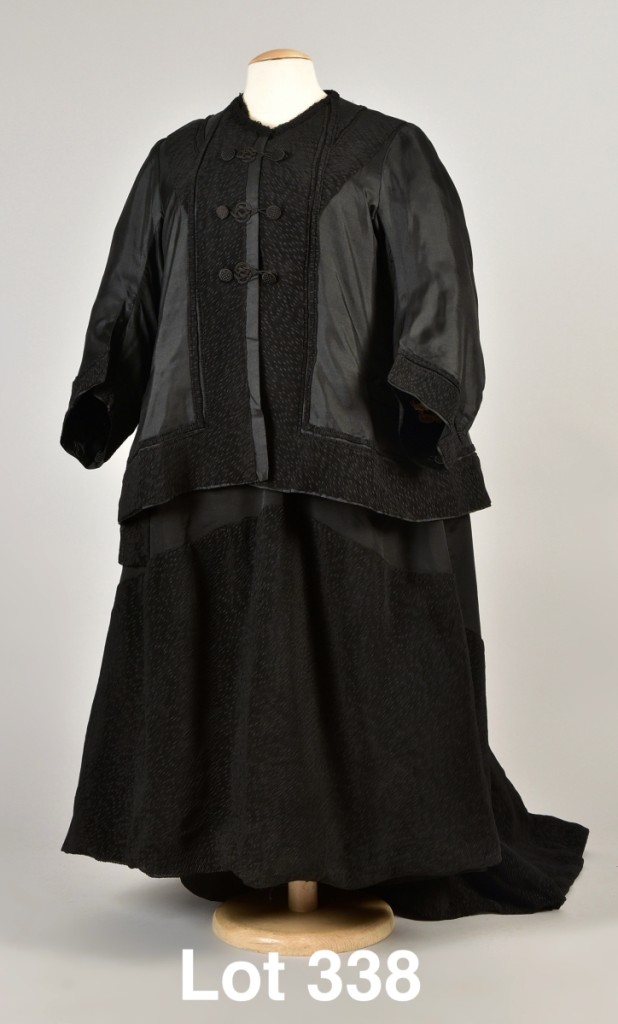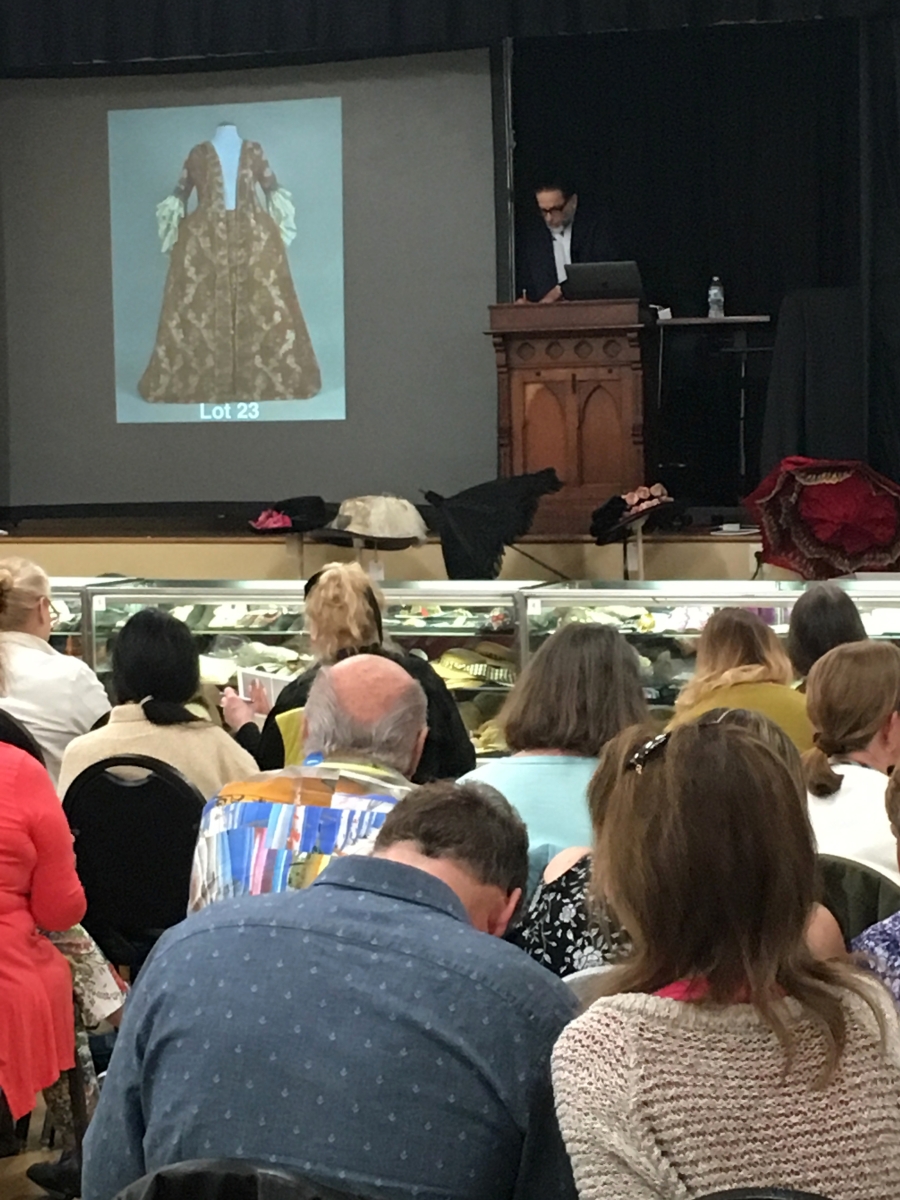
Queen Victoria’s three-piece black broadcloth silk day ensemble, in meticulous condition and complete with a small white silk patch at the back to help staff know when garments needed cleaning, sold for $37,200 at Charles O. Whitaker’s New Hope auction April 28. This piece was the top lot of the day.
Review and Onsite Photos by Jill Fenichell
NEW HOPE, PENN. – At Charles A. Whitaker’s April 28 auction of the legendary personal historic costume collection of Helen O. Larson, a three-piece black broadcloth silk day ensemble made for Queen Victoria sold for $37,200, topping its estimate by nearly six times, and making it the subject of supposition that it had been bought for an institutional collection or Asian bidder. Not only in wonderful condition, the garment included a small square of white silk, sewn to the back neck of the bodice, to help household staff determine when the queen’s garments needed to be cleaned.
As if to act as the exclamation point to the sentence that “royalty sells,” a pair of Queen Victoria’s black corded silk pumps, dating to the 1860s, sold for $15,600 against an estimate of $300/500.
Philadelphia-based auctioneer Charlie Whitaker joked after the sale, which took place at the Eagle Fire Company, that “it was a perfect storm” in which to offer such material this year, this month, since there is a royal wedding at the end of May, and a third royal baby was born just this week. Shows such as “Victoria” and “The Crown” have also renewed interest in the United Kingdom’s female monarchs.
The garment and shoes were but two items of many with royal provenance being offered from the private collection of Helen Larson. Larson’s stature looms large in the world of historic costume. She started collecting historic costume and textiles in the 1940s and continued to do so for 40 years as she ran, and later bought, Western Costume, a costume rental company in Los Angeles. The Larson collection had resided for decades at the Fashion Institute of Design and Merchandising (FIDM) in Los Angeles. It had been Larson’s hope that FIDM would be able to raise enough money to purchase the collection in its totality. That did not occur, so Larson family members allowed FIDM curators to choose certain items, while the bulk of the collection was auctioned at the Whittaker sale.
Doris Langley Moore helped Larson put together the collection, especially its royalty groupings – over a relationship that endured for decades. Moore herself founded The Costume Museum in Bath, England, which for many years was “the” museum collection of historic garments and textiles. Now, via institutional collections around the world in Paris, London, New York, Los Angeles, Kyoto and Toronto, among others – the interest in costume is worldwide, and its intensity dovetails and complements developments in contemporary fashion.
The Larson collection was able to buy a large grouping of royal outfits after World War II at a legendary Christie’s auction in London that was conducted on July 11, 1967. Then dubbed the “Queens Auction,” the collection offered at Whitaker’s included examples from Queens Victoria, Alexandra and Mary; Princess Louise of Prussia (a great-grand-daughter of Queen Victoria), Queen Louise of Denmark; Princess Elisabeth of Romania; Princess Marie Elizabeth of Wied of Schloss Monrepos, Neuwied; as well as children’s garments worn by the Prince of Wales (later Edward VII).

Institutions and private collectors from around the world also vied for Queen Mary’s sleeveless beaded and sequined sheath-dress, worn in the 1930s. This vision of delicate pink frothiness must have been surprisingly weighty to wear; it sold for $26,400.
Moore was assiduous in seeking out garments worn by royals, acquiring some, as noted, from “a niece of Harriet Giltrap, who was given or inherited articles from Giltrap, dresser to Queen Alexandra.” Other garments came via “a niece of Mrs Toogood,” another of Queen Victoria’s dressers. It is rare enough to come by articles with royal heritage, but to come by such garments with unquestionable provenance, and in such good condition, bringing bidders in person from as far away as Alaska, Maryland and New England. Whitaker pointed out that the royal garments were not only sold with tremendous provenance, but in amazing condition, having been kept in perfect temperature and in humidity-controlled environments for decades.
Titi Halle, proprietress of historic costume and textile dealer Cora Ginsburg, noted that it is difficult to gauge what interest for such items coming on the market might be, as they simply never come on the market in any large numbers, and not in such pristine shape. “I doubt this will ever happen again,” Halle commented. She bid on several lots for her own stock, as well as for institutional and private clients.
Other items with royal provenance that proved irresistible were Queen Mary’s beaded and sequined gown of pink lace, decorated allover with sequins, with a V-back and tulle neck insert for modesty. The sleeveless gown had an apt princess line and a short train. The queen would have been seen as very modern, as well as modest, two traits that symbolize how difficult it is to be royal. The fine garment, in lovely condition, and with another great provenance, sold for $26,400.
A cream trained linen and lace day dress, embroidered with flowers and vines, attributed to Queen Mary (and very similar to a dress with a certain Queen Mary provenance), sold for $20,400. This queenly figure has been rising in popularity of late, perhaps due to her depiction in the film, “The King’s Speech.” Mary’s life spread from the Victorian and into the mid-Twentieth Century.
Two slightly earlier stars of 1920s design also brought strong interest from international bidders. A rare stenciled kimono gown in soft grey by Italian fashion designer Mariano Fortuny bought the second highest price of the day, realizing $27,600 ($8/12,000). Fortuny garments retain their allure – their construction so simple, yet their drapery considered a lost art for decades.
Paul Poiret designed a vibrant purple sleeveless “flapper” dress encrusted with beads and with pointed zigzag hems that sold for $14,400 against a $6/8,000 estimate. This sleeveless sheath looked like it was ready to dance the “Charleston” off the auction floor.
The earlier part of the auction was devoted to costume of the Eighteenth Century, and this was why so many attendees decided to attend in person, from as far away as Alaska, to points south, and to New England, collectors, aficionados, dealers and historians gathered at the auction to admire, critique and to bid on what was on offer. Lot 1, a pair of cream satin shoes with gold braid, dating to 1680-1700, sold for $7,800. A couple in-house were triumphant over the phone, internet and other bidders, and walked away with their prize to accompany other early furnishings in their home.

Charlie Whitaker at the Podium with lot 23, a silk brocade sacque gown of the 1740s, which sold for $14,400. It had been exhibited at the Melbourne Arts Festival at “L’Epoque d’Elegance” in 1991 and supposition was that it returned to Australia to stay.
Halle said this section of the sale was a “triumph for shoes and hats and corsets…the accessories were incredibly strong.” Indeed, lots 14, 15 and 16, three early corsets, did sell for strong prices ranging from $2,580 to $3,900, with the earliest example realizing the highest price.
In this section of the sale, a personal favorite of nearly all the attendees was Maria Monroe’s pale blue French silk dress, embroidered with a neoclassical frieze to the hem, dated to 1814. The lot was accompanied by a note in Helen Larson’s handwriting, noting, “1814 Maria Monroe-daughter of James Monroe… Maria Monroe wore this dress when she was 10 years old and made news wearing it with pantalettes in Washington, DC.” It’s rare enough to find any fine garment for children of this period in the United States, let alone one of such fine appearance and made for such an important daughter of the post-Revolutionary period. The dress sold for $7,800, and one hopes to see it on view at one of the Monroe historic homes in Virginia.
The auction total for the sale totaled $1.1 million, with bidding from institutions such as National Gallery of Victoria (Melbourne); Historical Palaces, Royal Ceremonial Dress Collection (Hampton Court Palace, London); Newport Mansions (Newport, R.I); Colonial Williamsburg (VA); Museum at Fashion Institute of Technology (New York City); Museo de La Moda (Santiago, Chile); Peabody Essex Museum (Essex, Mass.) and the Bada Shoe Museum (Toronto). Additionally, there were institutions bidding online and through representatives in the room; assiduous private collectors in Asia and the United States, as well as in Europe. It is unlikely again that a collection of this magnitude, and stored as beautifully over decades, will hit the market anytime soon.
Prices quoted include buyer’s premium but do not include any applicable internet surcharge.
Whitakers is at 1002 West Cliveden Street. For additional information, 215-817-4600 or www.whitakerauction.com.





















